Teachers' Domain - Digital Media for the Classroom and Professional Development
User: Preview
Afterschool or out-of-school programs are more important than ever as schools and outside organizations try to help students maximize their learning time and develop the skills they need to master in-school assignments. Afterschool time can be used for academic enrichment or remedial instruction: a program will often have students in each category.
This professional development lesson will present information about how to use the student self-paced lessons in the Inspiring Middle School Literacy collection in afterschool programs for middle-school learners.
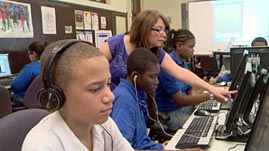
Afterschool curricula generally include activities for large groups, small groups, and one-on-one interaction. Hands-on activities, in which students make something or conduct an experiment, are particularly helpful for math and science learning. However, for students who need to improve their reading and English language skills—both native English speakers and English language learners—it can be challenging to find activities that involve active learning. The lessons in this collection address both this need for language instruction and engagement in learning.
While these lessons are designed so that students can work independently and at their own pace, the teacher or facilitator plays an important role in ensuring maximum student learning and engagement.

Video: 2m 27s
This media asset was adapted from the PBS series In the Mix: "Teen Immigrants."
Each lesson helps struggling readers by offering key vocabulary definitions and practice, presenting information in a series of short, easy-to-manage screens and providing ample opportunities to practice comprehension and writing. But students are not likely to focus on any of these components. Instead, they are more likely to come away thinking about the content of the lessons, the questions they are asked about that content, and how the themes of the lessons relate to their own lives.
For example, the lessons “American Stories: Teens and Immigration” and “Character Conflict: Language Immersion” will likely resonate with students who are immigrants, the children of immigrants, or who attend school with students with these experiences. These lessons share stories of immigrant students and get students thinking about their own experiences with fitting in, worrying about losing their native identities, or dealing with separated families. Teachers or facilitators can talk about these experiences with students one-on-one or in small groups.
Click “View” on the left to watch a video from the "American Stories: Teens and Immigration" lesson.
Write down two questions that would ask students to connect the video to their own lives.
Computer-based instruction can offer students the opportunity for greater engagement and productivity while reading and writing. Each online lesson in this collection features videos that illustrate content and goal, and interactive activities that allow students to manipulate and organize ideas and apply their learning to new contexts.
In the lesson on teens and immigration, students can sort the common experiences faced by immigrants into three relevant categories in order to prepare for a writing assignment. Click "View" on the left to try the activity.
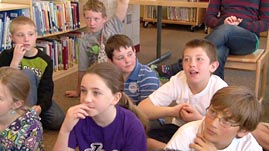
The content in each self-paced lesson can also be explored in creative ways beyond the lesson. Afterschool programs with community partners can collaborate with them to bring in people who can illustrate or elaborate on the lesson content. For example, for the lesson "The Story of Pocahontas," local artists might show students multiple representations of Pocahontas, illustrating how each generation has interpreted who she was and what she may have looked like. Architects or scientists might have students try to design and build a mini-pyramid for the lesson "Building the Pyramids of Ancient Egypt," and cultural interpreters might show students illustrations of Mayan artifacts for the lesson "Writings of the Ancient Maya."
Programs without community partners can work these types of enhancement and extension activities into the self-paced lessons themselves, bringing in guests or extra materials for special activities. Teachers may know individuals who could come in to speak to students or lead them in an activity, or teachers may collect or make books, games, or other items related to the topic of the lesson available to students.
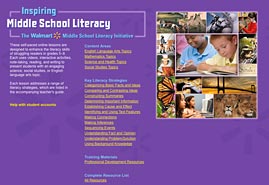
You can integrate these lessons into an existing afterschool curriculum to provide support for a content unit, to work on improving students' literacy skills, to support technology instruction, or to do any combination of the above. There are four content areas from which you can select a lesson: science and health, social studies, English language arts, and mathematics.
Review the lessons in the Inspiring Middle School Literacy collection and select one that you would like to try in your afterschool program. Write down the lesson you have selected and state why you have selected it.
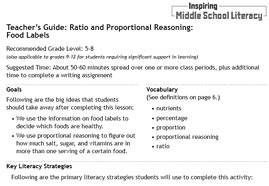
Once students begin the selected lesson, they will work at their own pace. Your role as the teacher/facilitator is to support them as needed. To begin planning how to get students started, download the Teacher’s Guide for your selected lesson (and print it, if you'd like). You will find it under “For Teachers” on the main page of the lesson. Each Teacher’s Guide will help you become familiar with the lesson and provides suggestions for how to support students before, during, and after the lesson. Note: “For Teachers” also provides technical notes that will help you get started.
Skim the entire Teacher’s Guide. Focus on the sections that are most relevant to your program. What strategies might you use to reinforce the content with students one-on-one or in groups? How might community partners play a role? Write your answer to these questions below.

Video: 0m 59s

Video: 0m 48s
While you may want to use the lessons one-on-one, students may also benefit from a larger group discussion before, during, or after the lessons. Teacher-facilitated or teacher-prompted discussions can help students develop comprehension and composition skills. These discussions also help ELL students perfect their English conversation skills and become more comfortable participating in a group setting. Since group work is central to almost every course a student takes in middle school, this is a valuable skill to sharpen in an afterschool setting.
You will now watch two videos to see how the teacher facilitates discussions after students have completed the lesson. The videos show in-school classrooms, but facilitation will be very similar in both in-school and afterschool settings. Notice how the students respond to the teacher and to each other. Click "View" on the left to watch each video.
Think about how the discussion topics in the video helped reinforce students' understanding of the lesson and helped them develop ideas for their final assignment. For the lesson you selected, what discussion topics do you think will be most relevant to the students in your program? If your program has ELL students, how might these discussions help them develop their English conversation skills?
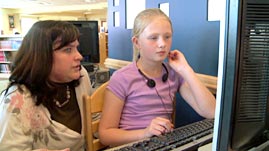
Struggling readers are all too often struggling writers; their difficulty understanding how written texts are organized and convey meaning makes it very hard to create their own written texts. ELL students as well as struggling native readers have problems with vocabulary, sentence structure, organization of ideas, and voice when they write. Afterschool time can be an opportunity for students to work on learning and applying the building blocks of good writing.
These self-paced lessons help familiarize students with these building blocks by providing structured instructions for note taking throughout the lessons. The online note-taking opportunities help students analyze and make sense of passages they have just read or videos they have viewed. These build to a full set of notes on the lesson that students can use to complete a long-form written assignment.
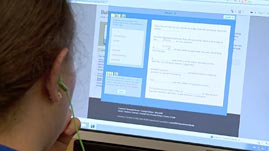
Measuring how afterschool time helps students improve their in-school performance is crucial. Assessment of student learning should include both ongoing, formative assessment and summative assessment at the conclusion of a unit of study. In each of these self-paced lessons, teachers have a range of formative assessment options: short-answer text boxes, multiple-choice questions, a vocabulary matching interactive activity, a content-based interactive activity, and group discussions.
These assessments will help you determine when students are ready to begin working on the final assignment and whether any students need additional support. Go to the “Lesson Assessments” page in your Teacher’s Guide and review the types of assessments that students will be completing. Be sure that you have tried each of the interactive activities so that you are prepared to answer any questions that students may have.
Choose one of the formative assessments for the lesson that you selected. Describe two ways you could help a student who is struggling to complete the assessment correctly.
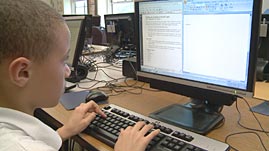
At the end of a lesson, teachers can evaluate what the student has learned and can apply to new situations. This summative assessment addresses whether students have achieved the goals of the lesson. Students are presented with a final assignment that offers a choice of two to three questions and select the one they feel most comfortable and knowledgeable in answering. They will use the saved notes from their formative assessments for reference when writing their final assignment.
Finally, asking students to self-assess their performance upon completion of the lesson improves their ability to self-regulate their learning and set goals for future tasks. Suggested self-assessment questions are available in the Teacher’s Guide.
Look at the final assignment questions for the lesson you chose. How would you help students select a question to answer? What might you do to help them plan and organize their response? How might you adapt this assignment to the learning styles and interests of your students?
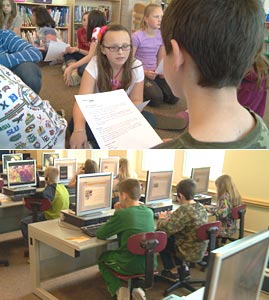
There are several ways to integrate self-paced lessons into your afterschool program. You might have students start work on one lesson and then wait until everyone has finished before you begin another. Or you might have small groups or student pairs work on different lessons.
You can also adapt the lessons to meet students’ needs and capabilities. If you have a writing-intensive program, you may find the final written assignment in the lessons to be a helpful practice exercise for long-response writing. If more students are struggling to write short-response items, you may want to focus the final assignment questions so that students can write a short response or have students draft an outline and then respond orally. You can also turn the final assignment into a debate or discussion topic for small groups or the entire group.
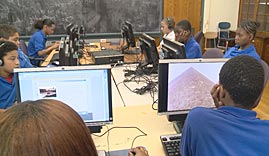
Now it’s time to review your responses in the previous sections and formulate a plan to use the lesson you selected in your program. Click “review my work” above and view or print out the screen that pops up. You can copy and paste the text into a word-processing file if you would like to edit the notes.
Teachers' Domain, Using Inspiring Middle School Literacy in Afterschool Programs, published August 31, 2012, retrieved on ,
http://www.teachersdomain.org/resource/midlit11.pd.splafter/
Media Type:
Self-paced Lesson
Professional Development:
WGBH is trying to develop materials that better meet the needs of our users. Please take this brief survey to share how you use these resources and to provide feedback on your experiences using these materials. Take the Survey!
This self-paced lesson designed for professionals in afterschool programs introduces the student lessons in the Inspiring Middle School Literacy collection and shows how they can be used to support struggling readers and engage all students in online, content-based lessons. While the student lessons are designed for students to work independently and at their own pace, the teacher or facilitator plays an important role in ensuring maximum student learning and engagement. This professional development lesson gets you started by describing the steps of using the student lessons in an afterschool program, including selecting a lesson, preparing before a lesson, assessing the lesson, and expanding the lesson in creative ways.
To help improve this service, please report and describe any standards correlations that you find to be inaccurate.
Academic standards correlations on Teachers' Domain use the Achievement Standards Network (ASN) database of state and national standards, provided to NSDL projects courtesy of JES & Co.
![]()
We assign reference terms to each statement within a standards document and to each media resource, and correlations are based upon matches of these terms for a given grade band. If a particular standards document of interest to you is not displayed yet, it most likely has not yet been processed by ASN or by Teachers' Domain. We will be adding social studies and arts correlations over the coming year, and also will be increasing the specificity of alignment.
You must be signed in to see standards matches for your state.
 Loading Standards
Loading StandardsMajor funding for Teachers' Domain was provided by the National Science Foundation.
Teachers Domain® Home | Change Edition
About Teachers' Domain | Contact Us | Privacy Policy | Terms of Use
Teachers' Domain: © 2002-2025 WGBH Educational Foundation | shopPBS Educational Media


